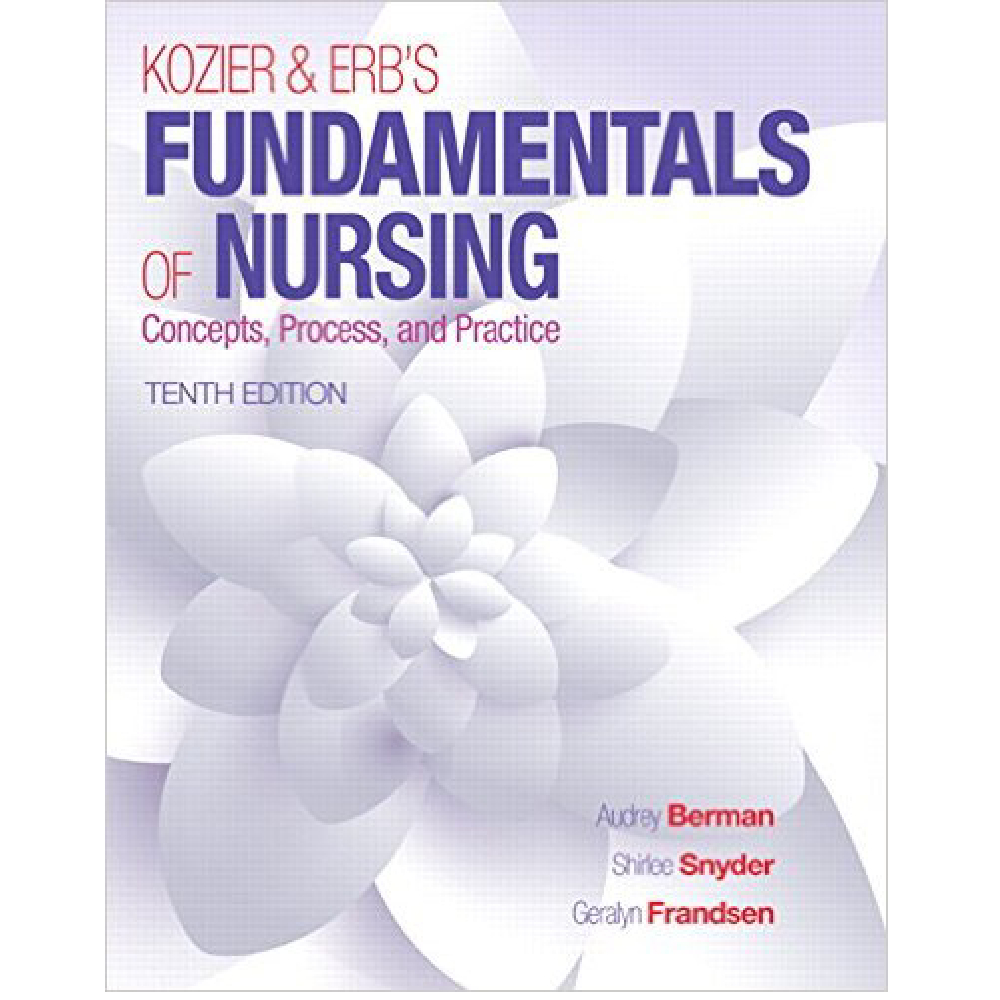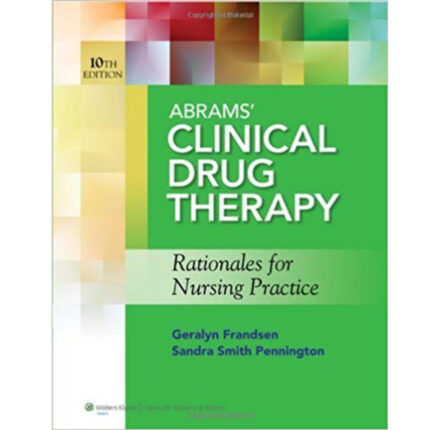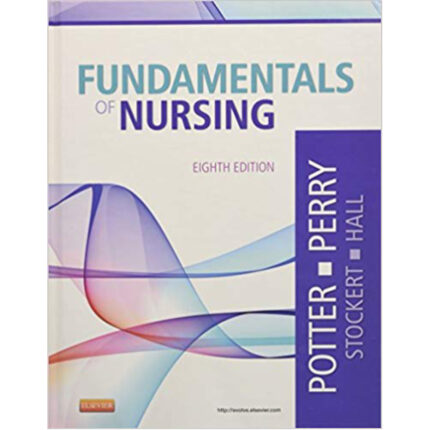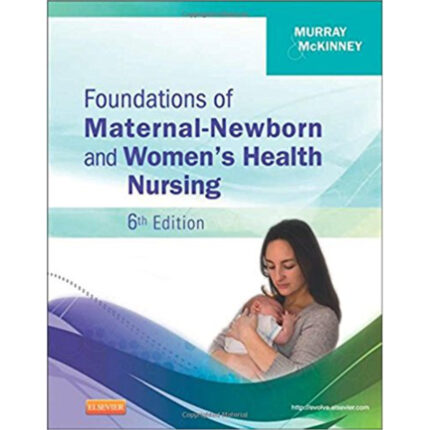Kozier And Erbs Fundamentals of Nursing 10th Edition by Berman Snyder – Test bank
Chapter 11
Question 1
Type: MCSA
The student is learning the steps of the nursing process. What is the first thing that the student should realize about the purpose of this process?
1. Deliver care to a client in an organized way.
2. Implement a plan that is close to the medical model.
3. Identify client needs and deliver care to meet those needs.
4. Make sure that standardized care is available to clients.
Correct Answer: 3
Rationale 1: Delivery of organized care is not part of the nursing process, although each phase is interrelated.
Rationale 2: The nursing process is not part of the medical model, as nurses treat the client’s response to the disease or problem.
Rationale 3: The purpose of the nursing process is to identify a client’s health status and actual or potential health care problems or needs, to establish plans to meet the identified needs, and to deliver specific nursing interventions to meet those needs.
Rationale 4: The nursing process is individualized for each client’s care plan. It is not about standardizing care.
Global Rationale:
Cognitive Level: Applying
Client Need: Safe and Effective Care Environment
Client Need Sub: Management of Care
QSEN Competencies: I.A. 1. Integrate understanding of multiple dimensions of patient centered care
AACN Essentials Competencies: IX. 1. Conduct comprehensive and focused physical, behavioral, psychological, spiritual, socioeconomic, and environmental assessments of health and illness parameters in patients, using developmentally and culturally appropriate approaches
NLN Competencies: Context and Environment; Practice; conduct population-based transcultural health assessments and interventions
Nursing/Integrated Concepts: Nursing Process: Planning
Learning Outcome: 1. Describe the phases of the nursing process.
MNL Learning Outcome: 1.4.1. Analyze the role of assessment in the establishment of the nursing process.
Page Number: 155
Question 2
Type: MCSA
While conducting a dressing change, the nurse notes a new area of skin breakdown that was caused from the tape used to secure the dressing. In which phase of the nursing process is the nurse working?
1. Assessment
2. Diagnosis
3. Implementation
4. Evaluation
Correct Answer: 1
Rationale 1: Assessment is the collection, organization, validation, and documentation of data. Assessment is carried throughout the nursing process, as in this case. Even though performing the dressing change is implementation, noticing the new skin breakdown is assessment.
Rationale 2: Diagnosis is identifying the client’s response to the problem. Implementation is what the nurse does to help the client reach a goal, and then the goal is evaluated.
Rationale 3: Even though performing the dressing change is implementation, noticing the new skin breakdown is assessment.
Rationale 4: The goal of the intervention is evaluated, but that is not what is being described in this scenario.
Global Rationale:
Cognitive Level: Applying
Client Need: Safe and Effective Care Environment
Client Need Sub: Management of Care
QSEN Competencies: I.A. 1. Integrate understanding of multiple dimensions of patient centered care
AACN Essentials Competencies: IX. 1. Conduct comprehensive and focused physical, behavioral, psychological, spiritual, socioeconomic, and environmental assessments of health and illness parameters in patients, using developmentally and culturally appropriate approaches
NLN Competencies: Context and Environment; Practice; conduct population-based transcultural health assessments and interventions
Nursing/Integrated Concepts: Nursing Process: Assessment
Learning Outcome: 4. Identify the four major activities associated with the assessing phase.
MNL Learning Outcome: 1.4.1. Analyze the role of assessment in the establishment of the nursing process.
Page Number: 159
Question 3
Type: MCSA
During an assessment, a client who is not very talkative appears pale, diaphoretic, and restless in the bed, and says “leave me alone.” Which subjective data should the nurse document?
1. Restlessness
2. “Leave me alone”
3. Not talkative
4. Pale and diaphoretic
Correct Answer: 2
Rationale 1: Restlessness is observable so it is not subjective data.
Rationale 2: Subjective data can be described or verified only by that person and are apparent only to the person affected. Subjective data include the client’s sensations, feelings, beliefs, attitudes, and perceptions of personal health status and life situations.
Rationale 3: Not being talkative is observable so it is not subjective data.
Rationale 4: Paleness with diaphoresis is observable so this is not subjective data.
Global Rationale:
Cognitive Level: Applying
Client Need: Physiological Integrity
Client Need Sub: Physiological Adaptation
QSEN Competencies: I.A. 1. Integrate understanding of multiple dimensions of patient centered care
AACN Essentials Competencies: IX. 1. Conduct comprehensive and focused physical, behavioral, psychological, spiritual, socioeconomic, and environmental assessments of health and illness parameters in patients, using developmentally and culturally appropriate approaches
NLN Competencies: Context and Environment; Practice; conduct population-based transcultural health assessments and interventions
Nursing/Integrated Concepts: Nursing Process: Assessment
Learning Outcome: 5. Differentiate objective and subjective data and primary and secondary data.
MNL Learning Outcome: 1.4.1. Analyze the role of assessment in the establishment of the nursing process.
Page Number: 160
Question 4
Type: MCSA
Family of a client demonstrating confusion state that this is not the client’s usual behavior. How should the nurse document this data?
1. Inference
2. Subjective data
3. Objective data
4. Secondary subjective data
Correct Answer: 3
Rationale 1: Inference is making a judgment, and that is not what is described in the question.
Rationale 2: The information provided by the spouse is not subjective because it is an observation by someone familiar with the client’s usual behavior.
Rationale 3: Information supplied by family members, significant others, or other health professionals are considered subjective if it is not based on fact. Because this information is factual, in that the spouse is able to provide the nurse with information about the client’s routine behavior and patterns, this is objective data.
Rationale 4: The information provided by the spouse is not subjective because it is an observation by someone familiar with the client’s usual behavior.
Global Rationale:
Cognitive Level: Applying
Client Need: Safe and Effective Care Environment
Client Need Sub: Management of Care
QSEN Competencies: I.A. 1. Integrate understanding of multiple dimensions of patient centered care
AACN Essentials Competencies: IX. 1. Conduct comprehensive and focused physical, behavioral, psychological, spiritual, socioeconomic, and environmental assessments of health and illness parameters in patients, using developmentally and culturally appropriate approaches
NLN Competencies: Context and Environment; Practice; conduct population-based transcultural health assessments and interventions
Nursing/Integrated Concepts: Nursing Process: Assessment
Learning Outcome: 5. Differentiate objective and subjective data and primary and secondary data.
MNL Learning Outcome: 1.4.1. Analyze the role of assessment in the establishment of the nursing process.
Page Number: 160
Question 5
Type: MCSA
The nurse provides a back rub to a client after administering a pain medication with the hope that these two actions will help decrease the client’s pain. Which phase of the nursing process is this nurse implementing?
1. Assessment
2. Diagnosis
3. Implementation
4. Evaluation
Correct Answer: 3
Rationale 1: Assessment is gathering data, and this is not what is described in the question.
Rationale 2: Diagnosis is identifying patterns and making inferences, and this is not what is described in the question.
Rationale 3: Implementation is that part of the nursing process in which the nurse applies knowledge to perform interventions.
Rationale 4: Evaluation is making criterion-based evaluations, and this is not what is described in the question.
Global Rationale:
Cognitive Level: Analyzing
Client Need: Physiological Integrity
Client Need Sub: Basic Care and Comfort
QSEN Competencies: I.A. 1. Integrate understanding of multiple dimensions of patient centered care
AACN Essentials Competencies: IX. 1. Conduct comprehensive and focused physical, behavioral, psychological, spiritual, socioeconomic, and environmental assessments of health and illness parameters in patients, using developmentally and culturally appropriate approaches
NLN Competencies: Context and Environment; Practice; conduct population-based transcultural health assessments and interventions
Nursing/Integrated Concepts: Nursing Process: Assessment
Learning Outcome: 1. Describe the phases of the nursing process.
MNL Learning Outcome: 1.4.3. Distinguish the nurse’s role in the implementation phase of the nursing process.
Page Number: 159
Question 6
Type: MCSA
A new client has been admitted to the care area. How soon should the nurse plan to complete a physical assessment on this patient?
1. 1 hour
2. 12 hours
3. 48 hours
4. 24 hours
Correct Answer: 4
Rationale 1: The Joint Commission requires that each client have an initial assessment consisting of a history and physical performed and documented within a specific time period, but not 1 hour.
Rationale 2: The Joint Commission requires that each client have an initial assessment consisting of a history and physical performed and documented within a specific time period, but not 12 hours.
Rationale 3: The Joint Commission requires that each client have an initial assessment consisting of a history and physical performed and documented within a specific time period, but not 48 hours.
Rationale 4: The Joint Commission requires that each client have an initial assessment consisting of a history and physical performed and documented within 24 hours of admission as an inpatient.
Global Rationale:
Cognitive Level: Applying
Client Need: Safe and Effective Care Environment
Client Need Sub: Management of Care
QSEN Competencies: I.A. 1. Integrate understanding of multiple dimensions of patient centered care
AACN Essentials Competencies: IX. 1. Conduct comprehensive and focused physical, behavioral, psychological, spiritual, socioeconomic, and environmental assessments of health and illness parameters in patients, using developmentally and culturally appropriate approaches
NLN Competencies: Context and Environment; Practice; conduct population-based transcultural health assessments and interventions
Nursing/Integrated Concepts: Nursing Process: Planning
Learning Outcome: 10. Contrast various frameworks used for nursing assessment.
MNL Learning Outcome: 1.4.1. Analyze the role of assessment in the establishment of the nursing process.
Page Number: 159
Question 7
Type: MCSA
The nurse is admitting an infant to the care area. The parents and grandmother are present. What should the nurse use as the best source of data for this client?
1. Medical record from the child’s birth
2. Grandmother
3. Parents
4. Admitting physician
Correct Answer: 3
Rationale 1: The baby’s birth record is able to provide necessary information, but not to the same extent as the parents.
Rationale 2: Although the grandmother can support the parents during this time and may be able to offer some helpful information, she would not be the best source.
Rationale 3: The best source of data is usually the client, unless the client is too ill, young, or confused to communicate clearly. The parents would be able to provide the nurse with the most accurate, current information regarding the baby (diet, schedule, symptoms, etc.).
Rationale 4: The admitting physician will be able to provide necessary information, but not to the same extent as the parents.
Global Rationale:
Cognitive Level: Applying
Client Need: Safe and Effective Care Environment
Client Need Sub: Management of Care
QSEN Competencies: I.A. 1. Integrate understanding of multiple dimensions of patient centered care
AACN Essentials Competencies: IX. 1. Conduct comprehensive and focused physical, behavioral, psychological, spiritual, socioeconomic, and environmental assessments of health and illness parameters in patients, using developmentally and culturally appropriate approaches
NLN Competencies: Context and Environment; Practice; conduct population-based transcultural health assessments and interventions
Nursing/Integrated Concepts: Nursing Process: Assessment
Learning Outcome: 6. Identify three methods of data collection, and give examples of how each is useful.
MNL Learning Outcome: 1.4.1. Analyze the role of assessment in the establishment of the nursing process.
Page Number: 161
Question 8
Type: MCSA
A newly admitted client is angry because nursing staff continue to ask the same questions. What should the nurse respond to this client?
1. “In order to make sure all of your information is complete, I need to ask these questions.”
2. “You’re right. Let me know if there’s anything you need right now.”
3. “I’ll be done shortly, just give me a few more minutes.”
4. “You shouldn’t be upset. We’re only doing our jobs.”
Correct Answer: 2
Rationale 1: Before asking more questions, the nurse should review what is already at hand.
Rationale 2: Repeated questioning can be stressful and annoying, especially for hospitalized clients, and cause concern about the lack of communication among health professionals. The nurse should review previous records that contain data about the client’s occupation, religion, and marital status, as well as take time to review all the information the previous nurse collected. Validating the client’s feelings is always a good idea and helps to build rapport between the nurse and client.
Rationale 3: This option does not address the client’s legitimate concern, nor does it acknowledge the client’s feelings.
Rationale 4: Telling the client “we’re only doing our jobs” is belittling to the client and doesn’t offer a therapeutic response.
Global Rationale:
Cognitive Level: Applying
Client Need: Psychosocial Integrity
Client Need Sub:
QSEN Competencies: I.A. 1. Integrate understanding of multiple dimensions of patient centered care
AACN Essentials Competencies: IX. 1. Conduct comprehensive and focused physical, behavioral, psychological, spiritual, socioeconomic, and environmental assessments of health and illness parameters in patients, using developmentally and culturally appropriate approaches
NLN Competencies: Context and Environment; Practice; conduct population-based transcultural health assessments and interventions
Nursing/Integrated Concepts: Nursing Process: Implementation
Learning Outcome: 9. Describe important aspects of the interview setting.
MNL Learning Outcome: 1.4.1. Analyze the role of assessment in the establishment of the nursing process.
Page Number: 163
Question 9
Type: MCSA
The nurse documents: “Client avoids eye contact and gives only vague, nonspecific answers to direct questioning by the professional staff. Is quite animated (laughs aloud, smiles, uses hand gestures) in conversation with spouse.” Which method of data collection does this documentation demonstrate?
1. Examining
2. Interviewing
3. Listening
4. Observing
Correct Answer: 4
Rationale 1: Examining is the major method used in the physical health assessment.
Rationale 2: Interviewing is used mainly while taking the nursing health history.
Rationale 3: Listening is only one part of observing.
Rationale 4: Observation is a conscious, deliberate skill that is developed through effort and with an organized approach. Observation occurs whenever the nurse is in contact with the client or support persons.
Global Rationale:
Cognitive Level: Analyzing
Client Need: Safe and Effective Care Environment
Client Need Sub: Management of Care
QSEN Competencies: I.A. 1. Integrate understanding of multiple dimensions of patient centered care
AACN Essentials Competencies: IX. 1. Conduct comprehensive and focused physical, behavioral, psychological, spiritual, socioeconomic, and environmental assessments of health and illness parameters in patients, using developmentally and culturally appropriate approaches
NLN Competencies: Context and Environment; Practice; conduct population-based transcultural health assessments and interventions
Nursing/Integrated Concepts: Nursing Process: Assessment
Learning Outcome: 6. Identify three methods of data collection, and give examples of how each is useful.
MNL Learning Outcome: 1.4.1. Analyze the role of assessment in the establishment of the nursing process.
Page Number: 164
Question 10
Type: MCSA
A nurse has worked in the trauma critical care area for several years. Which noise may become indiscriminate for this particular nurse?
1. A client with audible breathing
2. Moaning of a client in pain
3. Whirring of ventilators
4. Co-orkers discussing their clients’ conditions
Correct Answer: 3
Rationale 1: Nurses often need to focus on specific data in order not to be overwhelmed by a multitude of data. Observing involves discriminating data in a meaningful manner (i.e., noticing things that may indicate cause for concern or action on the nurse’s part). Listening to a client’s breathing helps the nurse become attentive to changes in breathing patterns.
Rationale 2: Nurses often need to focus on specific data in order not to be overwhelmed by a multitude of data. Observing involves discriminating data in a meaningful manner (i.e., noticing things that may indicate cause for concern or action on the nurse’s part). A client’s moans of pain should never become easy to listen to.
Rationale 3: The noises of machines and other equipment noises—except alarms—would be easy to ignore, as these are the usual, normal sounds of the unit.
Rationale 4: Nurses often need to focus on specific data in order not to be overwhelmed by a multitude of data. Observing involves discriminating data in a meaningful manner (i.e., noticing things that may indicate cause for concern or action on the nurse’s part). Listening to coworkers discuss other clients on the unit is helpful in case the nurse has to attend to any one of them.
Global Rationale:
Cognitive Level: Analyzing
Client Need: Safe and Effective Care Environment
Client Need Sub: Management of Care
QSEN Competencies: I.A. 1. Integrate understanding of multiple dimensions of patient centered care
AACN Essentials Competencies: IX. 1. Conduct comprehensive and focused physical, behavioral, psychological, spiritual, socioeconomic, and environmental assessments of health and illness parameters in patients, using developmentally and culturally appropriate approaches
NLN Competencies: Context and Environment; Practice; conduct population-based transcultural health assessments and interventions
Nursing/Integrated Concepts: Nursing Process: Assessment
Learning Outcome: 10. Contrast various frameworks used for nursing assessment.
MNL Learning Outcome: 1.4.1. Analyze the role of assessment in the establishment of the nursing process.
Page Number: 165













Reviews
There are no reviews yet.